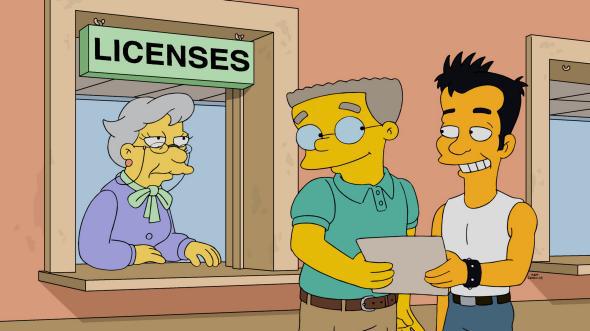How do you come out when everyone already knows you’re gay? It seemed The Simpsons was about to tackle that deep-gay question when executive producer Al Jean revealed, last September, that Waylon Smithers would come out in the show’s 27th season. Now that the episode in question has aired, it seems the pre-show publicity was more than a tad overblown. Smithers didn’t get to tell the world he’s gay but at least he was able to make Montgomery Burns, the love of his life, understand how much he cares.
In the first act of “The Burns Cage” (a pun, needless to say, on gay movie The Birdcage), a near-death experience helped Smithers realize that Mr. Burns would never let him confess his love, much less reciprocate it, which allowed him to finally snap out of his crush. That’s the best thing Smithers has done for his mental health since he first appeared on the show in January 1990, but it left him so mad at the world that he forced Homer, Lenny, and Carl to do some actual work at the nuclear plant. To get Smithers off their backs, the guys decided to find him a boyfriend, so they used a phone app to attract a gay crowd to the Simpsons’ house. Sure enough, Smithers was soon vacationing in Havana with bartender Julio—a character who has appeared in at least two previous gay-themed episodes. Sadly for the cute couple, Julio soon realized that Smithers was still devoted to his former boss. Mr. Burns, meanwhile, was so unhappy with his substitute sycophant that he acknowledged Smithers’ affection, and the men embraced.
There’s never been any doubt that Smithers is in love with Mr. Burns—and while he hasn’t made a formal declaration of his homosexuality, over the years he’s gotten more comfortable with people knowing his truth. When Homer ran into a rainbow-stripe-accented-booty-shorts-wearing Smithers outside the Stonewall Bakery in “Three Gays in the Condo,” which first aired in 2003, Smithers claimed he was only in the gay neighborhood because he was en route to a “big, uh, auto-racing festival.” Eight years later, in 2011’s “Flaming Moe,” Smithers tried to get Moe to turn his tavern into “a hangout for guys like me,” but when it came time to explain exactly what kind of guy that was, he whispered the description in Moe’s ear. Viewers didn’t hear Smithers’ words, though Moe rephrased them into the euphemism “swishkabobs.”
Last Friday, the New York Post published a sweet story noting that the Smithers storyline was inspired in part by the coming-out experience of Simpsons writer Rob LaZebnik’s son, Johnny. It seems odd and a little sad, then, that Smithers wasn’t really allowed to come out. It’s great that so many of Smithers’ friends and neighbors understand that he’s gay and want to help him find a boyfriend. It’s just too bad the show’s writers don’t seem to realize the psychological cost of forcing him to stay silent about an important part of his identity. Look again at the video above. There’s real pain in Smithers’ eyes when Mr. Burns prevents him from telling him something important that he really wants to share. It’s all very well to outfit Smithers in the symbols of gayness—cute rainbow parachute!—but it’s cruel of The Simpsons’ writers not to let Waylon Smithers control his own narrative.
